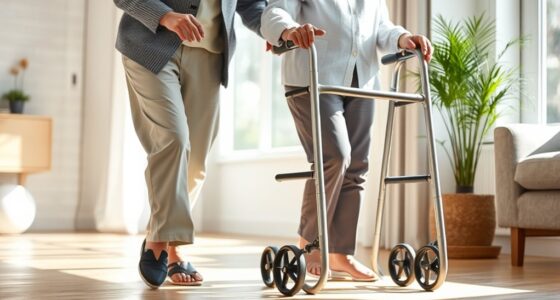To create an emergency exit plan for mobility-impaired seniors, assess their unique needs, guarantee clear and obstacle-free routes, and use accessible signage and lighting. Keep assistive devices nearby and well-maintained, and practice evacuation drills regularly. Communicate the plan clearly with visual cues and calm instructions. Continuously update and refine these procedures to address changes in mobility or environment. If you want to learn more about making your home safer, keep exploring this important topic.
Key Takeaways
- Assess individual mobility needs and home environment to create personalized emergency evacuation plans.
- Select and maintain accessible exit routes and assistive devices that accommodate mobility aids.
- Develop clear communication strategies, including visual signs and alarms, for effective emergency response.
- Conduct regular drills and practice tailored evacuation procedures to ensure preparedness and confidence.
- Continuously review and update emergency plans to incorporate new safety features, equipment, and environmental changes.
Understanding the Unique Needs of Mobility-Impaired Seniors
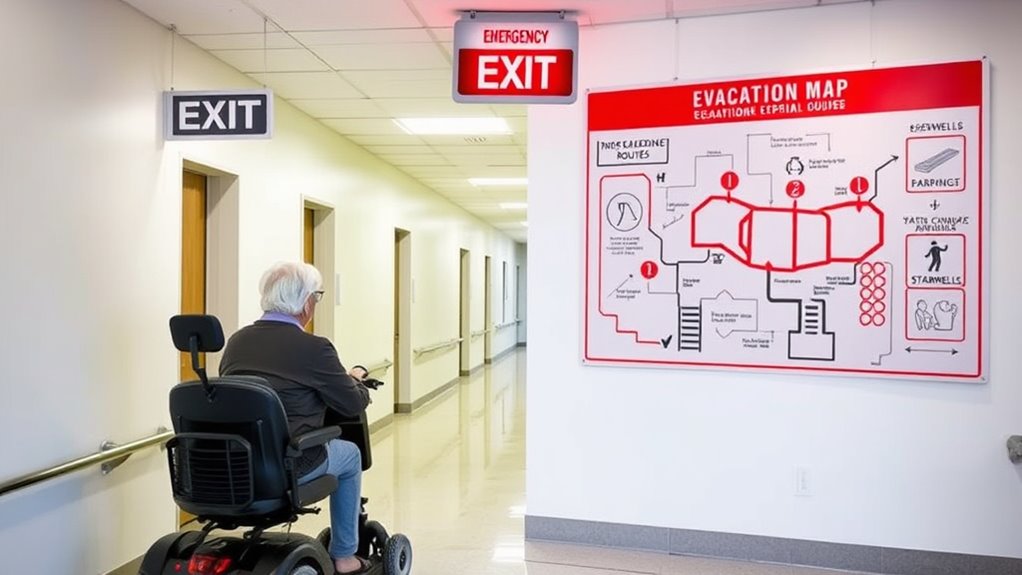
Understanding the unique needs of mobility-impaired seniors is essential for creating effective emergency exit plans. You need to take into account how assistive technology can support their safety, such as wheelchairs, stairlifts, or emergency alert devices. These tools help seniors navigate quickly and securely during emergencies. Additionally, tapping into community resources can make a significant difference. Local organizations, senior centers, and emergency services often offer specialized support, training, and equipment to assist mobility-impaired individuals. By understanding these needs and available resources, you can develop tailored plans that ensure quick, safe evacuations. Recognizing the importance of assistive technology and community support helps you create a thorough, practical approach that prioritizes safety and accessibility for seniors with mobility challenges.
Assessing the Home Environment for Emergency Readiness
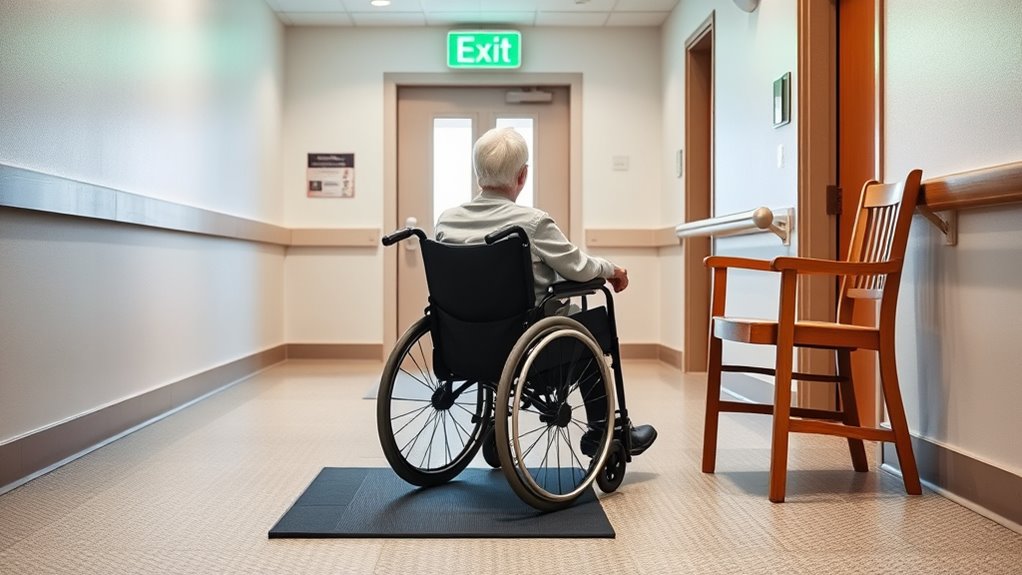
You need to make sure your home has clear pathways free of obstacles so you can move quickly in an emergency. Check that emergency equipment, like fire alarms and alarms, is easily accessible and within reach. Making these adjustments can greatly improve your safety and readiness. Regularly reviewing your risk assessment can help identify potential hazards and ensure your environment remains safe.
Clear Pathways and Obstacles
To guarantee safe and quick evacuation during emergencies, it’s essential to evaluate the home environment for clear pathways and potential obstacles. Ensure hallways, doorways, and exits are wide enough for mobility aids and free of clutter. Remove loose rugs, cords, and furniture that could cause falls or block escape routes. Install accessible signage with clear, high-contrast labels to guide you to exits quickly. Regularly check for obstructions, especially near stairways, windows, and emergency exits. Keep pathways well-lit and unobstructed at all times. Incorporating AI-enabled assistive devices can further enhance safety by providing real-time alerts and guidance during emergencies. These steps help create a safe environment, allowing mobility-impaired seniors to evacuate efficiently. Consistent obstacle removal and clear signage reduce confusion and delay during emergencies, making your home a safer space for everyone.
Emergency Equipment Accessibility
Ensuring emergency equipment is easily accessible is vital for a swift response during crises. You should verify that assistive technology, like grab bars, stair lifts, or emergency call buttons, are within reach and functional. Keep these devices in designated spots so they’re easy to locate quickly. Additionally, emergency signage plays a key role; clear, visible signs indicating the locations of fire extinguishers, exits, and emergency kits help guide you during an emergency. Regularly check that these signs are unobstructed and legible. Organize your home to minimize delays in reaching emergency equipment, and consider labeling key areas for quick identification. Prioritizing color accuracy guarantees you can respond promptly, reducing risks and enhancing safety during emergencies.
Selecting Appropriate Emergency Exit Routes and Devices
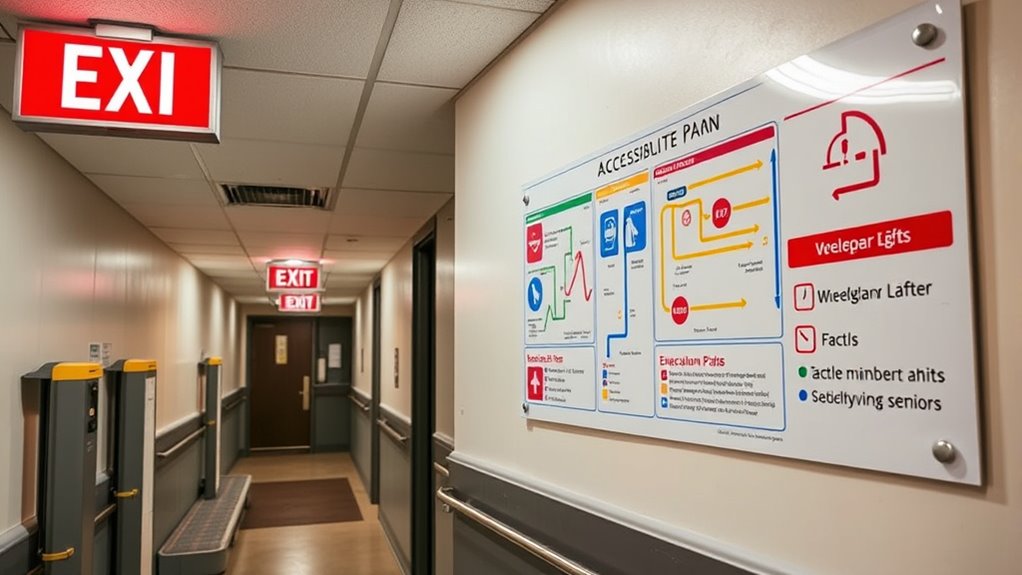
Choosing the right emergency exit routes and devices is essential for mobility-impaired seniors, as it can mean the difference between safe evacuation and dangerous delays. Start by identifying clear, unobstructed escape routes that accommodate mobility aids. Make sure emergency exit signage is visible and easy to understand, guiding you quickly to safety. Proper escape route lighting is also critical, illuminating pathways even if the power goes out. Consider installing illuminated signs and backup lighting along the route to ensure visibility at all times. Use wide, level paths free of obstacles, and ensure doors along the route are easy to open. Selecting routes and devices that prioritize visibility and accessibility helps you evacuate efficiently and safely during an emergency. Additionally, understanding life safety regulations can help you ensure your emergency plans meet necessary standards for accessibility and safety.
Planning for Assistive Device Accessibility and Usage

Planning for assistive device accessibility and usage is vital to guarantee mobility-impaired seniors can evacuate quickly and safely. You need to confirm their assistive technology is readily available and functioning properly during an emergency. Imagine these steps:
Ensure assistive devices are accessible, maintained, and seniors are trained for quick, safe evacuation during emergencies.
- Keep devices like wheelchairs, walkers, and hearing aids in accessible, designated spots for instant use.
- Regularly perform device maintenance to prevent malfunctions when emergency strikes.
- Train seniors on how to quickly operate and adapt their assistive technology under stress.
- Be aware of signs of spoilage in devices like hearing aids or batteries to ensure they are safe and reliable.
Communicating the Emergency Plan Effectively
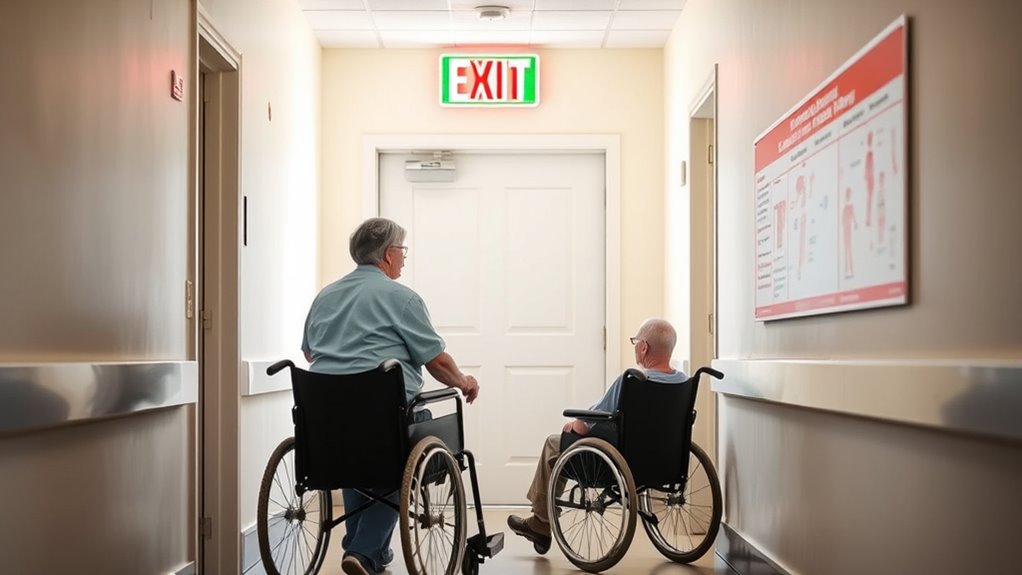
Once assistive devices are in place and ready, it’s essential to communicate the emergency plan clearly to seniors. Use simple language and visual signage to reinforce instructions. Make sure alarm systems are loud enough and distinguishable, so seniors recognize them immediately. Visual signage, like exit maps and directional arrows, should be placed at key points for quick reference. Here’s a quick overview:
| Method | Purpose |
|---|---|
| Visual Signage | Guides seniors to exits and safe zones |
| Alarm Systems | Alert seniors instantly to emergencies |
| Verbal Instructions | Reinforce visual cues during emergencies |
| Written Plans | Provide easy-to-understand written guides |
| Regular Drills | Practice helps seniors remember the plan |
Effective communication guarantees seniors respond swiftly and safely in emergencies. Incorporating emergency preparedness strategies tailored for mobility‑impaired seniors can further enhance safety and response times.
Training Family, Caregivers, and Emergency Responders
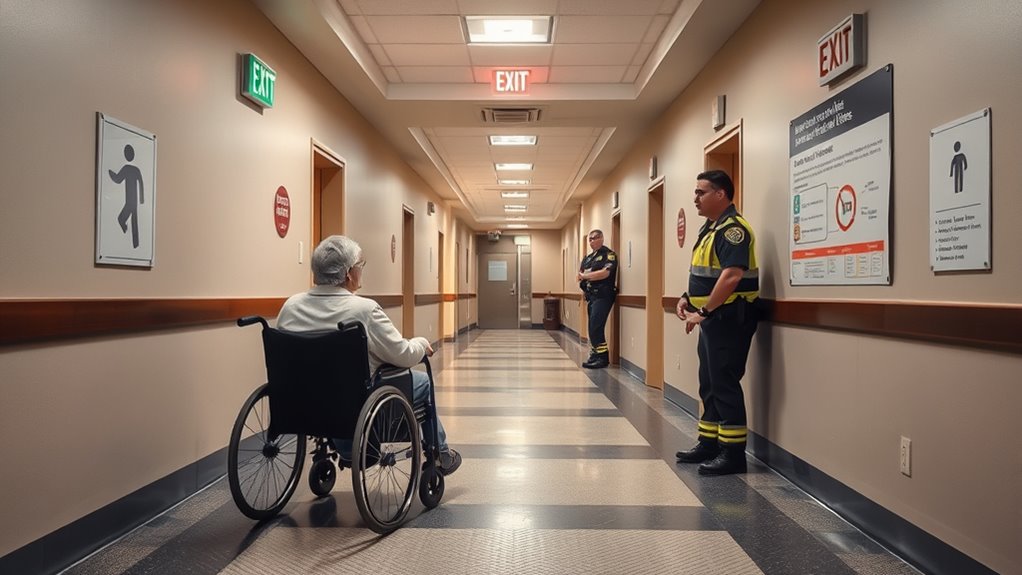
Training your family, caregivers, and emergency responders is essential for a safe evacuation. You should focus on effective communication strategies, practical drills, and customizing emergency protocols to each individual’s needs. These steps guarantee everyone is prepared and knows exactly what to do in an emergency. Incorporating self watering plant pots concepts such as maintaining consistent and reliable systems can serve as a helpful analogy for establishing dependable procedures in emergency plans.
Effective Communication Strategies
How can you guarantee that everyone involved in an emergency responds quickly and effectively? The key is clear communication. First, ensure all family members, caregivers, and responders are trained to recognize visual signage that indicates exit routes and hazards. Second, familiarize them with alarm systems, so they respond immediately to alerts without confusion. Third, use consistent language and signals during training to reinforce understanding. Practice speaking calmly and clearly, emphasizing essential instructions. Keep emergency information accessible and visible, like laminated cards near alarm panels. Regularly update everyone on new signage or system changes. Additionally, understanding emergency signage can help prevent confusion during a crisis. These strategies help create a coordinated response, reducing panic and delays, and ensuring mobility-impaired seniors get the assistance they need swiftly.
Practical Evacuation Drills
Practicing evacuation procedures through practical drills guarantees that everyone involved is prepared to respond swiftly and confidently during an emergency. Regular drills help identify potential obstacles and improve coordination among family members, caregivers, and emergency responders. During these exercises, emphasize fire safety by practicing alarm responses, safe exit routes, and assisting mobility-impaired seniors. Incorporate community resources such as local fire departments or emergency services to provide guidance and support. These resources can offer expert advice, conduct walkthroughs, or even participate in drills to ensure everyone understands their roles. By rehearsing different scenarios, you build confidence and reduce panic during actual emergencies. Ultimately, practical evacuation drills foster a proactive approach, ensuring safety and minimizing risks for seniors with mobility challenges. Additionally, understanding asset division laws can help families prepare for potential legal considerations following an emergency.
Tailored Emergency Protocols
To guarantee a swift and coordinated emergency response, it’s vital to develop tailored protocols for family members, caregivers, and emergency responders. These protocols ensure everyone knows their specific roles during an emergency. For example, you might:
- Conduct fire safety training, emphasizing how to assist mobility-impaired seniors quickly and safely.
- Share community resources, like local support teams and accessible transportation services, so responders know where to turn.
- Create clear communication plans, including medical needs and mobility aids, to prevent confusion during evacuation.
- Incorporate vetted baby safety products and equipment to support emergency preparedness and ensure safety during evacuation or shelter-in-place scenarios.
Practicing and Refining the Evacuation Procedure
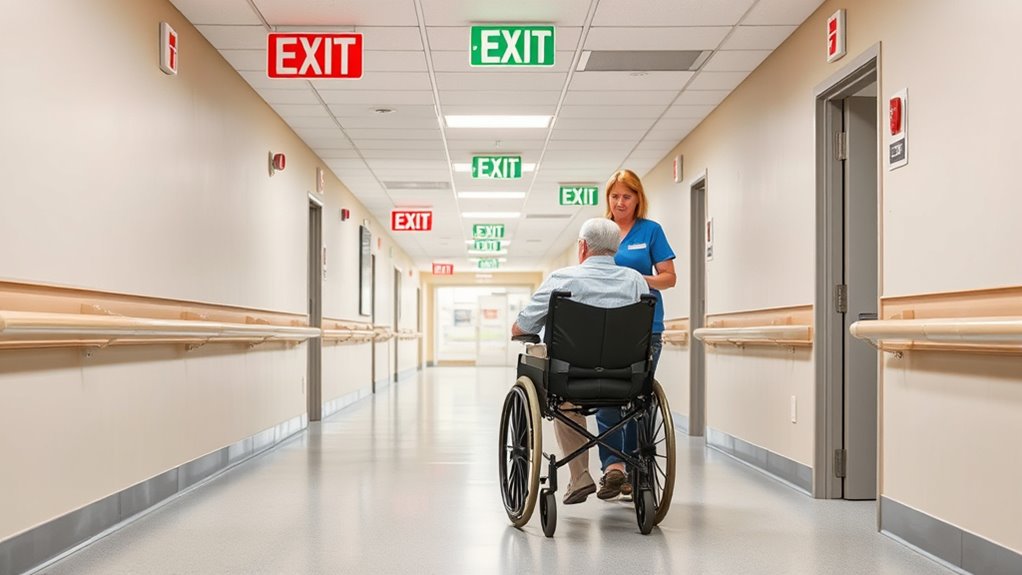
Regularly practicing and refining your evacuation plan guarantees that everyone knows their role and can respond quickly in an emergency. Focus on perfecting evacuation timing to ensure a swift, coordinated response. Repeated drills help identify potential delays and allow you to adjust procedures accordingly. During practice, pay attention to emotional preparedness—helping seniors stay calm and confident reduces panic and confusion. Encourage open communication and reassurance to build trust and reduce anxiety. Use real-life scenarios to simulate different situations, making your team more adaptable. Review and update the plan based on practice outcomes, ensuring it remains effective. Consistent rehearsals enhance both physical readiness and emotional resilience, making your emergency response more efficient and less stressful during actual emergencies.
Maintaining and Updating the Emergency Exit Plan
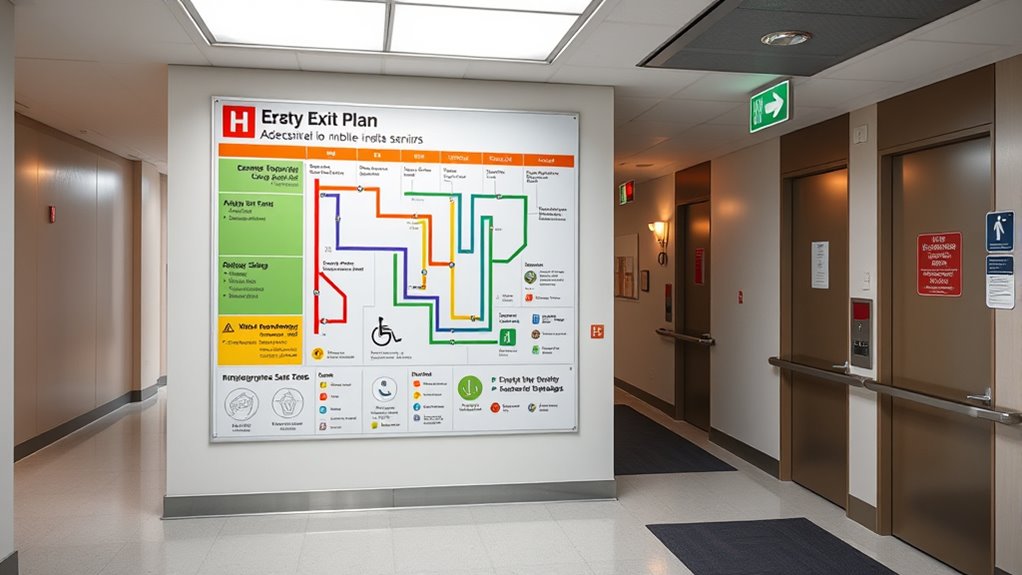
Keeping your emergency exit plan current is essential for guaranteeing it remains effective during a crisis. Regular updates help maintain home safety and ensure your plans reflect any changes in mobility or environment. To do this, you should:
- Review the plan every six months, checking that all routes and equipment are accessible.
- Incorporate new safety features or assistive devices as needed.
- Practice the updated plan with family or caregivers to reinforce emergency preparedness.
Frequently Asked Questions
How Often Should Emergency Exit Plans Be Reviewed and Updated?
You should review and update your emergency exit plans regularly, ideally every six months, to guarantee they’re effective. Incorporate evacuation drills to test the plan’s practicality and identify any issues. Customize the plan for mobility-impaired seniors, considering their specific needs. Regular updates and drills help everyone stay prepared, improve response times, and ensure safety during emergencies. Staying proactive with plan reviews is key to effective emergency management.
What Funding Options Are Available for Assistive Emergency Evacuation Devices?
When exploring funding options for assistive emergency evacuation devices, you should consider various funding sources and available financial assistance programs. Grants, government aid, and non-profit organizations often provide support, helping cover costs. You can also look into local community resources or insurance reimbursements. By researching these options, you guarantee you access the necessary funds to improve safety and mobility during emergencies, making sure your needs are prioritized effectively.
How Can Neighbors Assist With Emergency Evacuations for Seniors?
Did you know that community support can considerably improve emergency outcomes for seniors? As a neighbor, you can assist with emergency evacuations by offering to check on mobility-impaired seniors regularly. Volunteer training programs can prepare you to help safely and efficiently. Your involvement guarantees seniors feel supported and can evacuate quickly when needed, making a real difference in their safety during emergencies.
Are There Legal Requirements for Emergency Exit Planning for Seniors?
You should know that legal requirements and safety regulations often mandate that buildings, especially those serving seniors, have clear evacuation plans. These laws aim to guarantee everyone’s safety during emergencies. You’re responsible for understanding local codes, which may specify accessible routes and assistance procedures. By complying with these requirements, you help protect seniors and ensure quick, safe evacuations during emergencies. Always stay updated on regulations to meet safety standards effectively.
What Technologies Can Enhance Emergency Communication for Mobility-Impaired Seniors?
Think of emergency communication as your safety net, catching you when you fall. You can augment it with smart home integration, which links alarms and lights to alert you quickly, and wearable alert systems that keep you connected no matter where you are. These technologies work together to ensure mobility-impaired seniors receive timely assistance, transforming the chaos of an emergency into a more manageable situation.
Conclusion
By creating a thorough emergency exit plan, you’re not just preparing—you’re saving lives. Every detail you consider could be the difference between chaos and safety when seconds count. Your proactive steps could be the hero in a moment of crisis, ensuring your loved ones escape danger unharmed. Don’t leave their safety to chance—commit today, because in emergencies, your planning could be the only thing standing between them and disaster.


